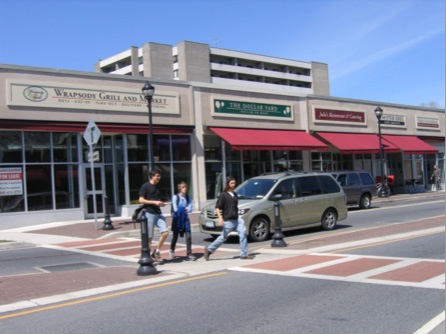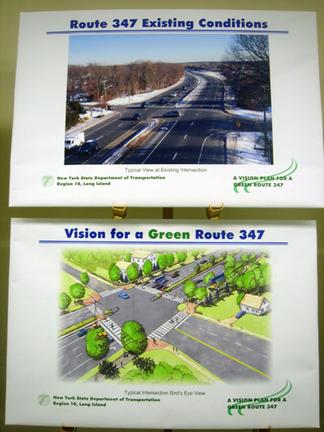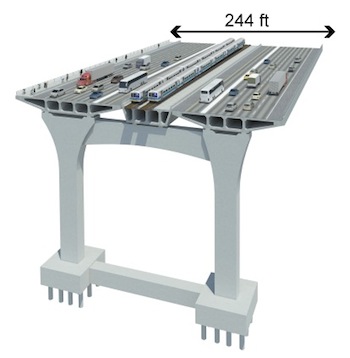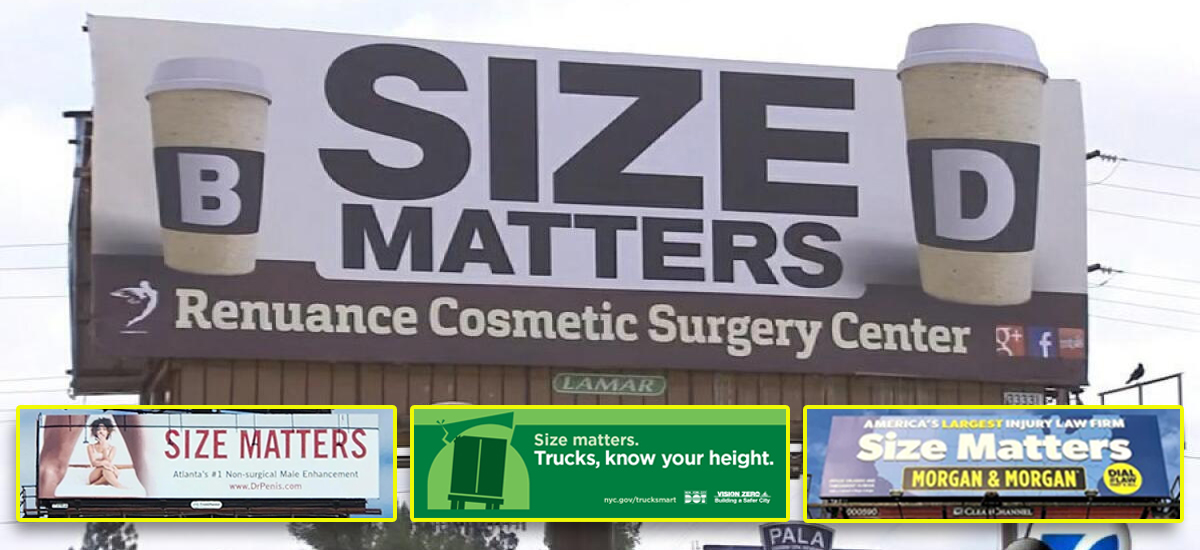“By building more and more roads, we have made it almost impossible to solve our transportation problems”
- Allen Biehler, Secretary, Pennsylvania DOT and Chair, AASHTO Standing Committee on Highways
Every state Department of Transportation (DOT) is led by a chief executive. In some states, they're called the "secretary." In others, the "director." In New York, we call the state DOT chief “commissioner,” and last week, Governor Cuomo named Joan McDonald as the next Commissioner of New York State DOT.

Although they have been reluctant to play an active role in land use planning, state DOTs have a huge impact on how their states grow and develop. Since the dawn of the post-WWII freeway era, the vast majority of state DOTs have declined to address concerns which we now group under the banners of sustainability and livability. The result has been unsustainable growth (sprawl) and precarious dependence on a single mode (driving). This in turn has produced extreme vulnerability to rising fuel prices, mounting emissions that have us on a course for catastrophic climate change, and alarming declines in public health.
Ironically, single-minded spending on high-speed freeways has not even accomplished transportation goals. Congestion has grown exponentially worse; more than 1,000 people lose their lives on New York’s roads each year; and the physical condition of transportation infrastructure is declining.
It is time to accept that transportation investments in livability and sustainability are essential to New York’s future, and incoming Commissioner McDonald must lead the way. DOT chiefs have enormous capability to set agendas, shift billions of dollars in transportation investments, and change agency culture. Commissioner McDonald can help New York pick itself up and get back into the race with other states leading the way on 21st Century transportation policy. In so doing, she can build on the foundation for smart transportation and land use solutions that the previous administration began to create, before getting sidetracked by financial woes.
Will McDonald follow the innovative path set by New York City’s own Janette Sadik-Khan, or will she run a state DOT content with business-as-usual planning? In the hopes that the Cuomo Administration recognizes that in tough financial times, New York needs more progressive transportation planning and investment, not less, below are a series of recommendations based on my work with state DOTs around the country.
1. Take the nationally trend-setting GreenLITES program to the next level
The NYSDOT GreenLITES program is a brilliant effort to integrate principles of livability and sustainability into transportation projects from start to finish, which has already received national recognition. Early GreenLITES initiatives have retrofit roads to prevent pollution from stormwater runoff and, in partnership with the Nature Conversancy, targeted invasive species in the Adirondacks.
GreenLITES can be powerful because it begins at the beginning, with the selection of projects. We have to start feeding smart, sustainable transportation projects into the state DOT pipeline, otherwise we’re just dressing up 20th Century solutions to make them appear like 21st Century solutions. For instance, some have called the application of complete streets and sustainability principles to the widening of Route 347 in Long Island a case of transportation greenwashing.

As one of her first steps, Joan McDonald should reconsider the wisdom of continuing to pour precious capital dollars into hugely expensive road widening projects, like the conversion of Route 17 into I-86. Think of it this way: Would you use the money you need to stop your roof from leaking to buy glitzy new kitchen appliances instead? We can no longer hope that channeling hundreds of millions into projects like the I-86 "upgrade" or the extension of Route 219 in Erie County will magically revitalize economies in various parts of New York state, while critical infrastructure crumbles in areas where most of New York’s existing population and economic wealth already reside. Instead, Commissioner McDonald should expand the GreenLITES program into agency-wide policy, practice and guidelines.
2. Enact performance-based goals and policies
Building on the GreenLITES pilot and programs such as STARS in Portland, Oregon, NYSDOT needs to evaluate its performance based on a broader range of goals than moving traffic. Success should be judged according to the agency’s effect on the environment, energy conservation, housing affordability, land use, and social equity.
3. Implement the land use and transportation program that Astrid Glynn started
Former DOT Commissioner Astrid Glynn came into power with the Spitzer administration in 2007, tasked with building a transportation and land use planning program to foster smart, compact growth. A new initiative modeled on NJDOT’s innovative Future in Transportation program seemed primed to launch with 12 full-time transportation and land use planners to implement it. It was aborted due to funding issues, which is unfortunate, because a well-run land use planning initiative, pursued in partnership with local communities, could save NYSDOT hundreds of millions of dollars that will otherwise be spent widening roads and chasing sprawl.
4. Foster the creation of NGOs around the state to oversee implementation of transportation and land use visions
The state DOT’s internal transportation and land use program should be complemented by parallel programs outside the agency. Why? Because even when state, regional and local government agencies successfully coordinate their planning efforts, they can still have trouble implementing them. Without a third party to hold individual agencies accountable to each other and to sticking to the joint vision, communities quickly succumb to the pressures that destroy livable places. A smart plan for sustainable growth can fall apart, for instance, if one municipality starts chasing after the tax receipts generated by big box development.
These watchdog organizations would have to be entities outside of government, so that they can avoid being dominated by politics.
5. Fully engage the public in long range planning
Every state DOT formulates and adjusts a long-range plan in collaboration with the various regions throughout that state. Engaging the public so that real decision making is shared with citizens during the long range planning process will be essential to the success of transportation agencies in the 21st Century. Due to the abstract nature of the planning process, which involves lots of ideas but few details, it has been difficult to figure out how to accomplish this. In this author’s opinion, this is a major reason why transportation agencies can no longer muster public support for tax increases to build and maintain infrastructure.
There is one superb model for the incoming Commissioner to borrow from: the 2004-05 New Hampshire DOT Long Range Business Plan. Instead of following the conventional top-down process, then-Commissioner Carol Murray turned it upside down, enlisting the New Hampshire Charitable Foundation to organize a public constituency. NHDOT provided participants with data on the state’s transportation needs and funding resources. These people then shaped the plan, relying on professional planners for direction and specific advice. In other words, the state DOT used its expertise to support and nurture public goals, instead of dictate them. The result: For the first time in decades, New Hampshire residents advocated for increased revenues for the DOT.
6. Trust and engage your career staff
New administrations often come into power with a mistrust of career staff, imposing change from the top down. The incoming administration should understand that there are many enlightened change agents in the state DOT bureaucracy, who if engaged, can dramatically accelerate reforms thanks to their competence and understanding of how to get things done. Having worked closely with or trained a number of NYSDOT staff over the years, I know for a fact that they already have a wealth of such committed talent.

7. Operate and oversee the entire system, not just the segments under the control of the state DOT
NYSDOT must evolve into a truly multi-modal agency that can influence the operations and performance of the entire transportation system, not just the portion of the state highway system that is under their jurisdiction. For instance, it needs to make itself responsible for seeing that transit in corridors like the I-287 Tappan Zee Bridge project actually gets done, instead of simply leaving room on the bridge for someone else to build it. To meet the challenges of the 21st Century, we need to knit together the operations of the multitude of transit services as well as the street and highway capacity of state, county, local and toll jurisdictions. To the citizens of New York, the system needs to appear seamless and legible. I recognize that this will pose all sorts of political problems, having lived through several attempts at accomplishing this in New Jersey. Nevertheless, we can no longer be daunted by the obstacles.
8. Transform NYSDOT’s mission from “building transportation through communities” to “building communities through transportation”
All of the above strategies should be employed according to the principle that transportation is not an end to itself, but a means to support the places we inhabit. Planning transportation through the prism of place is the key to busting the silos that all transportation agencies and jurisdictions now operate within. It is also the key to integrating transportation with land use, creating location-efficient housing, helping health departments address obesity and diabetes, and improving the quality of our watersheds and solving other ecological problems.
Place-based – or “upside down” – planning involves shifting the focus of transportation and land use planning so that it no longer simply reacts to entrenched patterns and trends, treating traffic and sprawl like irresistible forces that must be accommodated. Instead, a place-based approach involves collaboratively setting a course based on the outcomes we want to see for our communities. Then transportation planning and projects can be used to shape and support the future that we want. Organizing around place will elevate transportation to be a positive force in the growth of New York State.
Gary Toth is currently director of transportation initiatives at Project for Public Spaces. Previously, during his 34-year career with the New Jersey Department of Transportation (NJDOT), Gary become one of the architects of the transformation of NJDOT to a national leader in context-sensitive transportation planning. Gary’s work has brought him into contact with the operations of many state DOTs around the country. He is one of the leading experts on what “makes DOTs tick,” and how to engage the transportation planning, funding, project development and design processes to achieve sustainable and livable outcomes.





